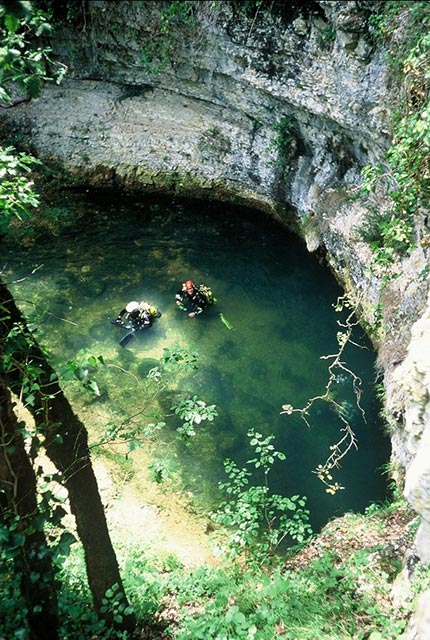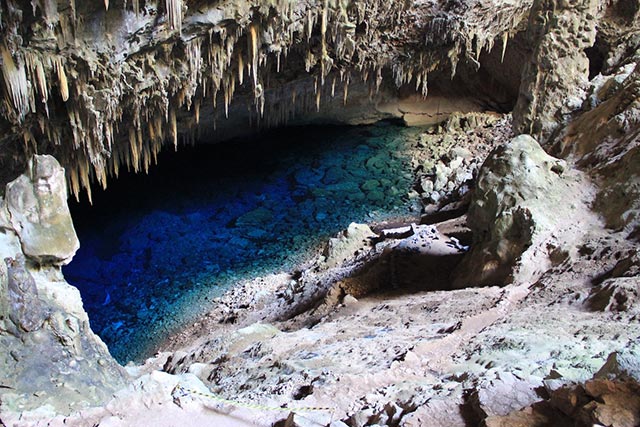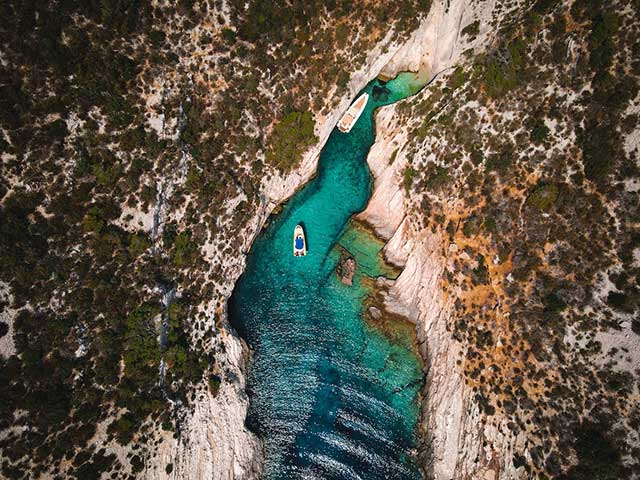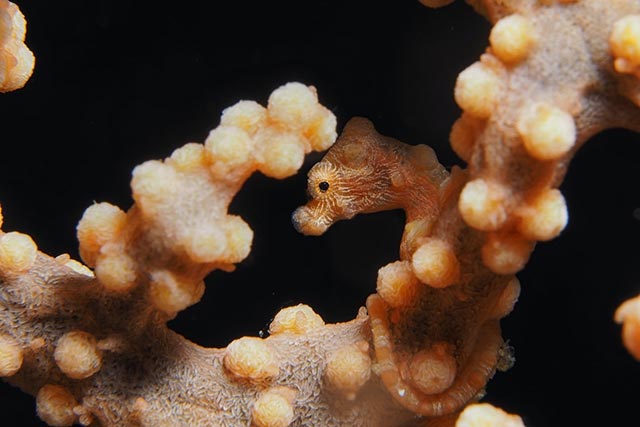Going beyond the light zone and exploring cave systems that few people ever get to see attracts divers to the world of cave diving every year. But you don’t need to be an experienced cave diver to enjoy some of the world’s most beautiful caves. Whether you’re an experienced tec diver, a new diver, or a snorkeler, there is a cave you can explore. Read on to find out more.
1. Cenote Dos Ojos, Mexico
The cenotes of Mexico are a cave diver’s dream, offering forest-draped sinkholes with clear azure waters and sunlit rock formations. There are over 6000 cenotes in Mexico and popular Dos Ojos boasts one of the largest underwater cave systems in the world.
 Image: Jared Rice/Unsplash
Image: Jared Rice/UnsplashStretching more than 80 km underground, Dos Ojoso contains the deepest known cave in Quintana Roo, The Pit. This 120-meter-deep cave system has multiple passages and an eerie layer of hydrogen sulphide formed by decomposing trees. It is a must-see for experienced tec divers.
2. Ginnie Springs, Florida, USA
To dive in Florida’s freshwater springs is like entering another world, with freshwater plants and fish in abundance and crystal-clear green waters. There are over 600 springs to choose from in Florida, offering something for swimmers, snorkellers, recreational divers and tec divers alike.
 Image: Luiz Cent
Image: Luiz CentGinnie Springs is one of the best-loved springs and was described by Jacques Cousteau as “visibility forever”. This warm clear spring has a network of underwater caves and plenty of wildlife, including alligators, manatees and turtles. All surrounded by hundreds of acres of lush woodland.
3. Fish Cave Rock, Australia
Fish Rock Cave is one of the best yet little-known highlights of scuba diving in Australia and offers excellent sea cave diving. Sitting close to the Australian continental shelf, this dive site has incredible biodiversity, including temperate and tropical species.
Known as one of the largest ocean caverns in the southern hemisphere, Fish Rock Cave runs for over 120 meters, straight through Fish Rock Island. As well as huge schools of fish, wobbegongs and stingrays, the cave hosts numerous grey nurse sharks all year.
4. Gozo’s Blue Hole, Malta
Gozo’s Blue Hole is one of the most famous dive spots in Malta and consists of a round 15-meter-wide hole that has been carved into the surrounding limestone by the power of waves and wind over thousands of years.
Dive in to explore a variety of eye-catching landscapes, including a cavern, chimney, and swim-throughs busy with colourful marine life.
5. Orda Cave, Russia
Orda Cave is high on the list for many cave divers. This enormous cave system is over 5 km long and is the longest gypsum cave in the world. Being made of gypsum and anhydrite rocks, the landscapes of this cave are continually changing; forming new passages and blocking others over time.

Whilst there is little life within the caves, the landscapes and blue waters of this unmissable dive site more than make up for it.
6. Emergence du Russel, Dordogne, France
The Dordogne region of France is at the forefront of cave diving and boasts some of the best cave dives in Europe. The Emergence du Russel is a popular cave system in Dordogne that starts in the bed of the River Céle as a winding passage around 150 meters long.
 Image: Bill Sanderson | All Rights Reserved
Image: Bill Sanderson | All Rights ReservedThis sinuous cave system splits into two passages that later reunite and plunges dramatically into a cavernous rift at around 45 meters deep, before descending to over 70 meters deep. Continuing onwards, it eventually shallows out and enters a dry cave section almost 2km from the start. If you like long cave diving adventures, this one is for you.
7. Chandelier Cave, Palau, Micronesia
The glittering stalactites and stalagmites of Palau’s Chandelier Caves are perfect for divers who want to enjoy the rewards of cave diving without committing to anything too full on.
 Image: Jakub Micuch/Unsplash
Image: Jakub Micuch/UnsplashThis system of five connected caves begins at a 3-meter wide opening, just 4 meters below the surface, and each cave has an air pocket. You’ll need a torch, the caves are pitch black, but there are many interesting creatures and features to find.
Look closely at the entrance to spot three depth charges left over from WWII and elusive mandarin fish. Further in, crabs and shrimps cling to sponges adorning the walls. But the greatest reward by far is the arching stalactites lit up by the light of your torch.
8. Nereo Cave, Alghero, Sardinia
Nereo Cave sits well within recreational diving limits and is famed as the largest cave in the Mediterranean Sea. With entrances to the cave at 16, 18 and 30 meters beneath the sheer cliffs of Capo Caccia, you can take your pick of different routes when exploring this cave and even complete a full circle dive.
This huge underwater sea cave boasts towering coral-covered arches and tunnels that host an abundance of marine life, including eels, crustaceans and red corals.
9. Anhumas Abyss, Bonito, Brazil
The famous Anhumas Abyss offers one of the most thrilling cave experiences for adventure seekers. To start with, you rappel down over 70 meters into this spectacular cave framed by enormous stalactites and stalagmites.
 Image: Ademir Alves/Unsplash
Image: Ademir Alves/UnsplashThe gin-clear waters at the bottom of the abyss are full of huge schools of fish and are lit up by sunlight for just a few hours of every day. Only 18 to 25 people can enter this unique environment each day, so make sure you are one of them.
10. Blue Caves, Zakynthos, Greece
Zakynthos is renowned for its Blue Caves, which attracts thousands of visitors every year. These remarkable caves feature a series of arches and caves with diverse underwater landscapes, though the unique water colour is what these caves are famed for.
 Image: Max van den Oetelaar/Unsplash
Image: Max van den Oetelaar/UnsplashAs light reflects on the water, it gives an eerie, almost glowing, blue colour to anything it touches. Visit in the morning light to make the most of this phenomenon and then continue onwards to dive Zakynthos’s numerous sea caves.
11. Cathedral Cave, Premuda, Croatia
One of the most popular dive sites in the Dalmatian Islands, Cathedral Cave at Premuda Island is a jewel in the crown of Croatia diving.
 Image: Miha Arh/Unsplash
Image: Miha Arh/UnsplashThis cave takes its name from having an enormous dome-like roof dotted with holes that allow sunlight to penetrate through. The bottom of the cave is covered in soft white sands and there are numerous tunnels and passageways to explore.
12. Twin Tunnels, Tulagi, Solomon Islands
The Twin Tunnels is a must-do dive in the Solomon Islands and is named for the two big vertical lava tubes. The tubes sit right next to each other in a sea mount and descend down to a cave at around 35 meters, which opens up onto a reef wall.
As you descend within the tubes, you’ll be surrounded by fans, whip corals and prized marine life, including pygmy seahorses and hairy squat lobsters. There are schools of fusiliers around the entrance and a fantastic reef to explore at the surface.
 Image: Pascal van de Vendel/Unsplash
Image: Pascal van de Vendel/UnsplashKathryn Curzon, a shark conservationist and dive travel writer for Scuba Schools International (SSI), wrote this article.
Main photo credit: Eberhard Grossgasteiger/Unsplash
Image credits:
- Cenote: Jared Rice/Unsplash
- Florida-springs: Luiz Cent
- Dordogne by Bill Sanderson: Bill Sanderson | All Rights Reserved
- stalactites: Jakub Micuch/Unsplash
- Bonito-Brazil: Ademir Alves/Unsplash
- Blue-Caves-Zakynthos-1: Max van den Oetelaar/Unsplash
- croatiacave: Miha Arh/Unsplash
- pygmy-seahorse: Pascal van de Vendel/Unsplash

















